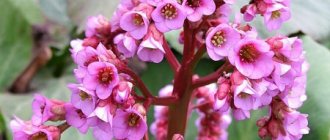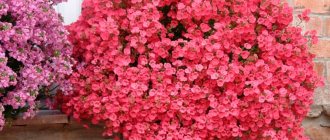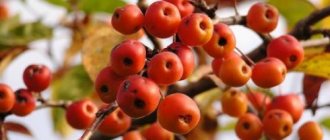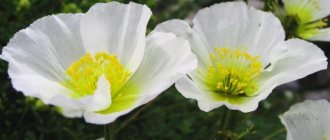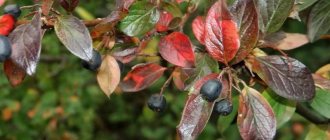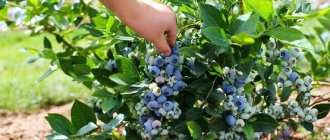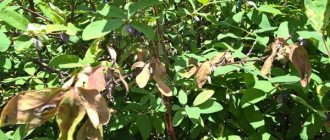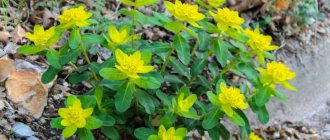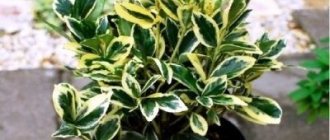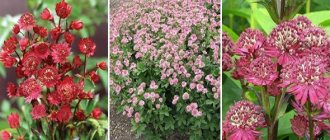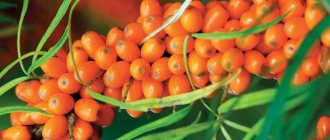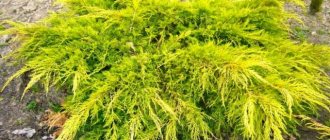Description of chokeberry
Aronia melanocarpa or chokeberry is a chokeberry, which is a fruiting representative of shrubs or trees from the Rosaceae family. From Greek, the name of this culture is translated as “benefit, help.” This shrub is native to North America.
Chokeberry is a winter-hardy, deciduous variety of shrubs that are characterized by strong branching. The maximum height is up to 3 m. Young specimens have a compact crown, but over the years its diameter reaches up to 2 meters.
The shoots of young trees are characterized by a brownish-red hue, which over time turns into dark gray. The leaves are simple, elliptical in shape. Their length is up to 0.08 meters, and their width is up to 0.05 meters. The upper part of the leaves is leathery and has a rich dark green color; closer to autumn they become coral-purple.
The flowers are snow-white or pink, the anthers are purple, and form corymbose-shaped inflorescences. Flowering can be enjoyed in May-June. The fruits of the tree are black in color, the weight of one berry is up to 1.5 g. Fruit ripening occurs in September or the second half of August.
Chokeberry as an ornamental shrub
In the flora of our planet, there are several species of chokeberry, which grow in the wild on the North American continent along the banks of rivers and lakes. They belong to the deciduous shrubs of the Rosaceae family. The most common type is chokeberry (Aronia melanocarpa) with small black berries.
Other varieties: strawberry-leaved chokeberry (also called arbutus-leaved chokeberry or arbutolifolia chokeberry), red chokeberry with red fruits that are inedible, so the plant is used mainly as an ornamental. Chokeberry chokeberry is a natural hybrid of chokeberry and strawberry chokeberry.
And the usual chokeberry, which we grow in our dachas, is not of natural origin at all. This is a hybrid that was developed by the Russian scientist I.V. Michurin, calling it chokeberry Michurin (A. mitschurínii). Its difference is large edible sweet and sour fruits. By the way, it is extremely rare in the wild - the propagation of shrubs mainly occurs accidentally, due to migratory birds. Scientists have recorded such cases in the pine forests of the Moscow and Vladimir regions.
Chokeberry Michurina was artificially created by scientists at the end of the 19th century. Michurin crossed the seeds of chokeberry (A. melanocarpa) with distantly related plants and mountain ash (Sorbus aucuparia). In turn, the common rowan has little in common with the chokeberry. “Chokeberry” has larger and tastier fruits than ordinary mountain ash, and a different set of chromosomes. The scientist himself recommended planting the new crop in forest belts, using it in areas with a harsh climate where few fruits grow. After all, even low temperatures down to -30-40 degrees Celsius will not kill such a crop.
The shrub has a height of up to 2 meters and a dense crown. This type of chokeberry blooms in May – June for 2 weeks. The flowers are white and fragrant, collected in corymbose inflorescences of about 20 pieces. The fruits of chokeberry are spherical, apple-shaped, slightly flattened on top and have a black-bluish tint. As for the taste, it is tart and sweet and sour. Chokeberry grows quickly and bears fruit. It is distinguished by late flowering, and the berries ripen before the first frost, without falling off. From one bush you can collect up to 10 kg of chokeberry.
Chokeberry is an unpretentious plant to care for; it is resistant to diseases and insect pests. Since the shrub blooms in late spring, it is not afraid of frost. In addition, this is a self-pollinating crop, this process occurs with the help of wind and insects, so the chokeberry yield is usually quite high.
Chokeberry reproduces by seeds and vegetatively. It is best to sow seeds in the garden at the end of October so that the seeds undergo natural stratification in natural conditions. They are deepened into the soil by 2 cm, and the seedlings will begin to bear fruit in the third or fourth year. The plant can be propagated vegetatively by dividing the bush, layering, cuttings or grafting - one- or two-year-old seedlings are used for this. For grafting, the rootstock of rowan berry is usually taken. If the crop is propagated by root suckers, by autumn they grow up to 40 cm and have a developed root system.
To plant chokeberry seedlings, choose lighted places where there is no wind, while placing the bushes two meters from each other so that the plants are not shaded. The optimal soil type is sandy loam and light loam with abundant watering. Throw the fertile layer of soil in one direction, and the bottom layer in the other.
First fill holes measuring 50x50x50 cm with fertilizers: humus, superphosphate and potassium sulfide are usually used. The hole is filled with this mixture, after which the seedling is placed there. Deepen the root collar a couple of centimeters. After planting, pour a bucket of water onto the seedling. Mulch the ground with humus, sawdust and dry soil. And to get maximum growth, trim up to 4 healthy buds from below at a distance of up to 20 cm from the soil surface.
When planted in a shady place, the chokeberry yield will drop significantly. If the soil is too fertile, shoot growth will occur at the expense of bud formation and, accordingly, the yield will decrease.
You will have to water the shrub especially often during the ripening period of the fruits so that they are not small and dry. And you can replant “Aronia Michurin” even with the leaves in full bloom.
Chokeberry requires regular pruning, since this shrub is characterized by rapid growth and formation of shoots. The base of the bush expands and fruiting decreases. To prevent this, you will need to form the crown of the plant.
After planting, the plant is pruned at a height of 20 cm above the ground. Next spring, 5 strong and well-placed branches are selected from the root growth and shortened so that the tops are at the same level. This will be the skeleton of the crown, and the remaining branches need to be cut at the base at soil level. Next season, the crown is “replenished” with 5 more branches, and a year later – with 5 more branches. As a result, a full-fledged crown will be formed in 3-4 years, because the number of stems in a chokeberry bush should be 15–20.
And when the bushes reach 15 years of age, they should be freed from old branches that have almost no berries. Chokeberry looks especially impressive when formed into a standard form, turning into a small tree.
Chokeberry is valued not only as a fruit crop, but is also known for its decorative properties. The plant looks spectacular at any time of the year. Chokeberry flowers are white in the spring, green in the summer or purple in the fall. Chokeberry is ideal for both single and group planting. Partners for this shrub can be crops that bloom in summer or autumn - for example, paniculate hydrangea, perennial asters, Korean chrysanthemums or Japanese anemones.
You can make a hedge from chokeberry. To do this, it is enough to plant the plants at a distance of 1 m from each other. But it is also planted for landscaping streets and parks. The shrub looks especially impressive in the fall, when it acquires a bright scarlet color with burgundy, purple, red and orange hues. This shrub is also used as an edge crop in a shelterbelt.
Since chokeberry is a moisture-loving plant, foresters often use this feature to cultivate waterlogged or swampy areas where moisture is retained during the rainy season. Another “consumer” of chokeberry is green construction. We have already talked about the plant’s changing outfit several times a year.
Chokeberry is good in the form of a bush on the lawn or as a small clump. Standard trees obtained by grafting chokeberry onto mountain ash or hawthorn also look impressive.
Such a fruit and berry crop as chokeberry has become useful for people as a nutritious and medicinal raw material. It is used as a vitamin remedy to strengthen the immune system, as well as for the prevention and treatment of many diseases: for example, high blood sugar, impaired metabolism, neurological problems or high blood pressure.
In addition, chokeberry is a decorative decoration for any summer cottage or local area, changing the color of the leaves throughout the year, or serves as a hedge. Therefore, it is often used in landscape design. And since chokeberry is a very gas-resistant shrub, it is planted for landscaping parks.
In the next video you will learn even more useful information about planting and caring for chokeberry.
www.eda-land.ru
Chokeberry: planting and care
Growing chokeberry begins with proper planting of the tree. It is better to give preference to fertile areas, but the culture is also neutral to sandy, dry soils, and is sometimes even capable of growing in acidic soils. The illumination must be full, otherwise achieving abundant flowering will be extremely problematic.
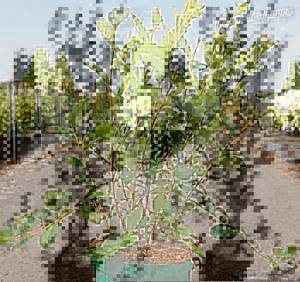
Chokeberry seedling
The optimal period for planting is considered to be autumn. When performing this process in the spring, it is better to do the procedure before the buds begin to open. Holes are prepared for the placement of the culture (parameters: 50 by 50 centimeters). The root system is placed in the planting hole so that the root collar is buried 1.5 centimeters. The top layer with which the hole will be filled is based on superphosphate (about 100 grams), humus, and potassium sulfide (60 grams).
When the seedling is planted, it must be watered with water (about 10 liters). Then mulching is carried out using sawdust, humus and dry soil. Immediately after planting the seedling, you will need to trim up to 3-4 healthy buds, this will guarantee strong growth.
Secrets of proper care
Chokeberry bushes require proper care depending on the season. With the onset of April, you will need to perform sanitary pruning. The bush is also sprayed with a composition against various diseases or pests. At the beginning of May, it will be necessary to remove the weeds that appear around the trees. Nitrogen compounds are used as fertilizers in spring.
In summer, close attention is paid to the presence of pests. To eliminate them, they resort to folk remedies or chemicals. Despite the drought resistance of the crop, it will also require additional watering on hot days. To do this, you will need at least 2 buckets of water for each bush. Watering should be done in the formed furrows; they are made 0.4 meters from the crown projection. Also, do not forget to loosen the area to remove weeds.

Autumn color of chokeberry foliage
The period when chokeberries ripen is at the end of August. But it is better to carry out this process only with the onset of the first frost. The fruits are carefully cut with scissors, the berries are not torn off. Knowing when to harvest chokeberries correctly will help prolong the freshness of the fruit.
An important point in growing a bush is preparation for wintering. In the fall, chokeberry is pruned (before the onset of cold weather), and young bushes are sure to spud. After the chokeberry ripens, the tree trunk circles will need to be covered with old leaves or spruce branches. Adult specimens overwinter well without additional covering materials.
How to feed chokeberry?
Chokeberry needs regular fertilization. On fertile soils, this process is usually carried out only in the spring; it is necessary to add only 50 grams of nitrate. The tree trunk circles are mulched on top using humus or compost.
For poor soils, another feeding will be needed, in addition to the spring one. The optimal period is considered to be the beginning of summer. Under the bush, add 10 liters of mullein diluted with clean water (ratio - 1 to 5). In the fall, when the harvest is harvested, another 500 ml of wood ash is added under the chokeberry, as well as superphosphate (100 grams each).
Features of chokeberry pruning
Pruning chokeberry begins immediately after planting, which contributes to the growth of green mass. Then next spring you will need to form skeletal branches (usually up to 12 of them).
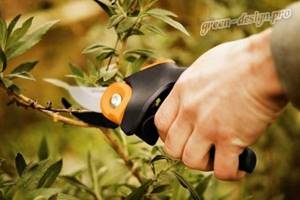
Don’t forget to remove thickening shoots every year. They can be shortened immediately after flowering, which will allow you to adjust the shape of the bush.
When the chokeberry turns 7 years old, you will need to remove the old branches, leaving only young and beautiful ones. After 10 years, the bush can be pruned to soil level. This helps rejuvenate the plant.
Features of caring for chokeberry
Watering requirements
Watering should be regular, the plant loves moisture, and in dry periods, chokeberry is watered more often, especially during fruit set. If there is insufficient watering, the berries will be small, so you need to make sure that the soil is moist all the time.
Fertilizers
Throughout the season, chokeberry is fed 3 times.
- If the plant grows on fertile soils, then one feeding in the spring is enough. Feed when the first leaves appear. To do this, use nitrogen-containing fertilizers (ammonium nitrate, urea, nitrophoska). Each bush is fed with them, and finally the tree trunk circle is mulched using manure, compost or humus.
- If the land is infertile, it is necessary to do another fertilizing in the summer. This procedure is done when the chokeberry begins to bloom. You can add potassium sulfate and organic fertilizers.
- The third time chokeberry is fertilized in the fall; for this, each bush is fed with 0.5 liters of wood ash and 100 g of superphosphate. But don’t get too carried away with fertilizing, as this can negatively affect fruiting.
Trimming
After some time, the chokeberry grows wider and upward. If pruning is not done, the bush becomes very thick, which affects the yield. The plant is pruned in the spring, when the buds have not yet bloomed. Shoots that are 7-8 years old are removed, as well as weak, damaged shoots and those that prevent the chokeberry from developing. Old bushes are rejuvenated by pruning and a bush is formed from young shoots. In the fall, branches that were damaged during harvest or damaged by pests are pruned as necessary. Don’t forget about such procedures as loosening the soil and killing weeds; this is done as needed throughout the season.
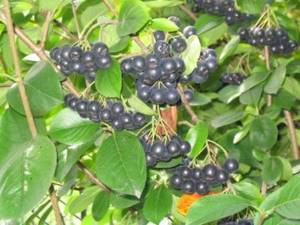
Rowan chokeberry
Propagation of chokeberry
Chokeberry reproduces well both by seed and by vegetative methods.
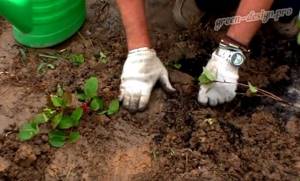
Vegetative method of propagation of chokeberry
But the most common options are sowing seeds and using cuttings. Let's focus on these two methods.
Cuttings
To propagate the plant using woody cuttings, you will need to use annual shoots obtained from 2-4 year old branches. They are cut in the first half of autumn. The cuttings should have 5-6 eyes, their length is up to 0.02 meters. It is strictly forbidden to propagate using the upper part of the shoot.
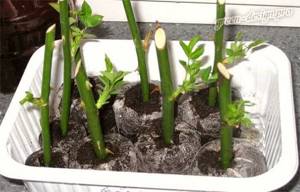
Aronia cuttings
The cut from above is made obliquely, and from below - directly, directly under the eye; cuttings should be planted in a direction of 45 degrees, making a distance of 12 centimeters. The soil around the cuttings is watered, and peat mulch is also made.
Planting seeds
To obtain seed material, the fruits are rubbed through a sieve, then the seeds are dipped into water to allow the pulp to float and rinse. The seed material is washed and mixed with sand (ratio – 1 to 3). It is extremely important to undergo stratification, for which the material is placed in the refrigerator for 3 months.
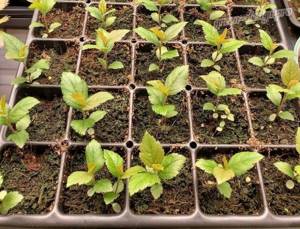
Chokeberry seedlings grown from seeds
When the seeds begin to hatch, they can be sown in the garden. For this purpose, special grooves up to 8 centimeters deep are formed. The bed is covered with rotted manure or sawdust. When the seedlings have 2 leaves, they need to be thinned out, making the distance between sowings 0.03 meters. Another thinning is performed after there are 5 leaves, the distance is left to 0.1 meters. At this time, remember to water the bed, loosen it, and eliminate weeds. You can replant the bushes to a permanent place of growth only in the fall of next year.
Landing rules
In order for chokeberry to take root, quickly grow and delight you with its fruits in record time, you should know in advance about the specifics of preparation and the nuances of directly planting plants on the site. First of all, you need to pay attention to the choice of location and soil cultivation.
How to choose the right place
The unpretentious chokeberry takes root well on almost any type of soil , often even without additional fertilizer. This ability makes it an excellent option for planting in areas with sandy soils, on rocky slopes and even in wetlands, but the most abundant harvests can be obtained when cultivated on drained, loose loam with a low acidity level.
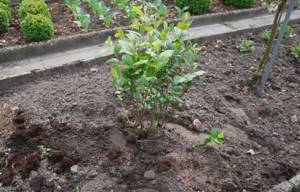
The plant is not afraid of groundwater , but a lack of sunlight can negatively affect the development of the bush, so it is advisable to plant seedlings in open areas, but always protected from cold gusts of wind (unlike adult plants, young ones are very sensitive to them).
In the process of organizing protection in the fields, rowan can be used to fill the middle tier of the forest belt . To prevent the soil under other plants from being washed away, shrubs are planted in holes and ravines without applying fertilizers (nutrients washed away from gardens usually already end up in such places).
Did you know? Since ancient times, rowan has been considered a symbol of family happiness. Our ancestors believed that preserving the color of the red chokeberry fruits laid out on the windowsill helped strengthen the family unit of household members.
Soil preparation
Having chosen a suitable place, about 2-3 weeks before planting the seedling, they begin to prepare the hole . Having dug a 50-centimeter hole, you need to add 1 bucket of peat, sand and compost to the top fertile layer, as well as one glass of superphosphate and ½ glass of potassium sulfide (60-70 g of any complex fertilizer can replace it). Having mixed all the components well, they are poured into a hole in the form of a hill.
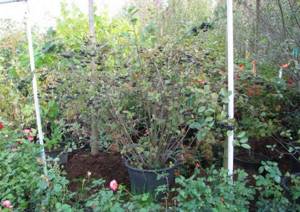
Young plants purchased in pots can be planted on the site throughout the entire gardening period , but if the purchased young plant has an open rhizome, you should focus on the autumn (preferably September-October).
Pre-planting preparation of the material consists of soaking the crop for half an hour in any root formation stimulator (for example, “Kornevin” or “Epine”). If we are talking about seedlings with an open rhizome, then the processing time in the stimulator increases to 6–12 hours. All broken, diseased or shriveled roots must be cut back to healthy, living tissue.
Important! Between neighboring rowan bushes you need to leave at least 1–1.5 m of free space, with the obligatory consideration of the future size of the adult chokeberry.
Planting process
Having prepared everything necessary and organized a planting place for the chokeberry seedling, it is taken out of the transport container and placed on the prepared hill, straightening each root. If a young seedling looks unstable, you can tie it to a support stake driven nearby. The root collar of the plant should go 3–5 cm deep into the soil , so even before filling the rhizome with soil, in this place the trunk can be lowered just below the line of the hole. After planting, all branches of the seedling are cut to a length of 15–20 cm, so that only 4–5 buds remain on each segment. This will stimulate the active growth of new shoots.
Video: Instructions for planting chokeberry
Chokeberry in garden design
Chokeberry looks good when used to form hedges.
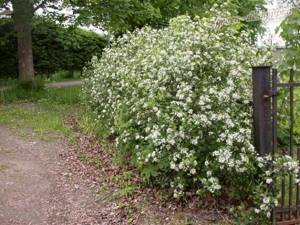
Using chokeberry as a hedge
You can combine the plant with Korean chrysanthemums, perennial asters, and hydrangea. Chokeberry berries become an excellent decoration for bushes in the autumn, so the trees are often planted singly, next to alleys or garden benches. The autumn foliage of the shrub will decorate any garden.
A hedge of chokeberry and common rowan
For any summer cottage, a living fence is a mandatory element in our time. Some summer residents are trying to make a chokeberry hedge into a full-fledged element of the landscape, taking into account the recommendations of professional gardeners, while others choose other shrubs and trees. A green fence will require constant care and trimming from the owner; it is much more pleasant to admire than a wooden or brick fence. With the help of a hedge made of mountain ash, you can protect your dacha area from animals, curious passers-by, and dust.
Attention! An original rowan hedge significantly improves the air in a personal plot, makes it fresh and fragrant, and reduces the tendency of dacha inhabitants to depression.
The advantages of a green hedge include:
- naturalness and environmental safety;
- low cost;
- aesthetics.
The main disadvantages of this fence option is the need for constant maintenance: watering, cutting, fertilizing. For those land owners who are not afraid of such difficulties, we recommend creating a decorative fence from chokeberry on their site. In addition to beautiful greenery, this shrub is distinguished by tasty and healthy fruits used in medicine to treat various diseases.
Features of chokeberry
This plant is a shrubby plant that sends out many shoots that fill the available space. The shrub is ideal for forming a hedge. It is no coincidence that chokeberry (aronia) is chosen by gardeners for a green fence. This plant does not need constant feeding; it is unpretentious to the soil and easily tolerates severe frosts and prolonged drought.
Advice! The shrub grows quickly, so leave free space for new shoots.
In order for the plant to have a beautiful and well-groomed appearance, it must be trimmed, doing this 2-3 times annually in one season. 10-15 years after planting, the bush will give you a beautiful and durable hedge that will delight you with its aroma and delicious berries.
Rowan propagation
Planting is possible using cuttings. Alternatively, seedlings can be grown from the main tree. To do this, the mother bush is pressed to the ground, dug in to a depth of 5-6 cm. The digging area is watered, loosened, and soil is added. After the young shoots appear, they are dug up and transplanted to a permanent place.
To form a beautiful and lush hedge from this green plant, planting is carried out in one row, leaving a distance of 50-60 cm between the bushes. Young seedlings are watered throughout the season, the degree of soil loosening is controlled, and weeds are removed.
Tools for creating hedges
Before you start planting your living fence, take care of your tools and materials. They will help speed up and simplify your actions, achieving the desired result without any problems.
The formation of a hedge involves the use of:
- shovels;
- secateurs;
- roulette;
- garden rake;
- wooden sticks and wire for the frame;
- peat or humus for feeding;
- electric or mechanical garden shears;
- brush cutter
Algorithm for making a rowan fence
To make a rowan hedge, use the following algorithm:
- First, make markings on the site so that the fence turns out smooth and beautiful. Planting of young seedlings should be carried out according to this marking.
- Start creating a living fence by planting in an area that is marked for a hedge of chokeberry bushes. A hole is dug 40-50 cm deep and 50-60 cm wide. You can put mineral fertilizer, humus, a mixture of peat and sand in the hole. After planting the seedling, 5-6 buds should remain on the surface of the ground.
- The distance between bushes is 1-1.5 meters.
Advice! Choose areas that are well lit by the sun for planting shrubs, otherwise the plant will develop slowly and you will not get the desired harvest.
- Constant pruning of seedlings is needed to form additional lateral branches.
- It is advisable to trim bushes in spring and autumn, in which case the bush will be dense and highly productive. Each haircut involves an increase in height by 15-20 centimeters. Trimming the tops of rowan trees should be done every month.
- To fix unruly rowan branches, you can use small sticks. They need to be placed in the ground to create two levels: internal and external, with a rowan bush growing between them.
Rules for caring for shrubs
If you decide to organize a square green rowan fence, then place the sticks around the perimeter of the square, periodically checking the evenness of the structure. To prevent unnecessary branches from appearing, check the frame after 3-4 weeks.
Basic actions that involve caring for a chokeberry living fence:
- systematic haircut;
- crown formation;
- getting rid of roots
After planting, a rowan bush should not have more than 3-4 branches; the densest buds are always left on the branch. As the plant grows, it is increased by 2-3 branches, and excess shoots are removed. An adult, mature bush consists of 10-12 branches of various ages. All old branches (from 7-8 years old) are removed from the rowan bush, the rowan is cut to the ground, and a new bush is formed from fresh shoots.
Nowadays, you can choose different varieties of ornamental shrubs to create an original living fence: Nero, Kutno, Viking, Belder, Rubina. When choosing a variety of this plant, it is advisable to take into account the climatic characteristics of your area and seek help from nursery staff. In this case, the risk of plant death due to temperature changes and increased climate humidity is reduced. If you follow the growing rules, 1-2 years after planting, a beautiful green hedge of fragrant chokeberry will turn green on your site.
bouw.ru
Chokeberry: beneficial properties and contraindications
Many gardeners, in addition to aesthetic appeal, are also interested in the benefits of chokeberry for the body.

Chokeberry contains many vitamins, thanks to which it helps cope with the following diseases:
- Hypertension. Provides a diuretic effect, which reduces blood volume and normalizes blood pressure.
- Atherosclerosis. Thanks to vitamins E and C, vascular walls are strengthened.
- Gastritis. The beneficial properties of chokeberry help to increase the level of stomach acidity.
- Nervousness. Chokeberry helps in reducing excitability, having a calming effect on the body.
- Diarrhea. Thanks to the tannins in the composition, the body has an astringent effect, which leads to normal digestion.
In addition, the health benefits of chokeberry are also observed by those with poor eyesight. Vitamin A reduces the risk of developing cataracts and glaucoma. Also, consumption of fruits is recommended for people living in areas with poor ecology.
A great way to preserve chokeberries for the winter is to dry the fruits. This method guarantees the preservation of the healing properties of the berries. It is better not to freeze, as this will lead to the destruction of valuable tannins.
Contraindications for the use of chokeberry fruits
Before preparing and picking chokeberry berries, you should familiarize yourself with the list of contraindications. It is not recommended to eat fruits for patients with angina pectoris, as this will lead to increased blood clotting, which can lead to the formation of blood clots. Patients with stomach ulcers should not eat berries.
Aronia chokeberry is not a rowan at all
The rose family (Rosaceae) includes two interesting genera of plants - Aronia and Sorbus. Chokeberry and rowan are relatives in the botanical hierarchy, but at the genus level they have biological differences. It is enough to look carefully at the structure of the leaves, the general habit of the plant, its distribution area, environmental requirements and chemical composition to understand that these are different plants. Translated from Greek, the specific epithet of chokeberry is translated as black fruit, hence the full name in Russian - chokeberry (Aronia melanocarpa). People often mistakenly call it chokeberry.
Chokeberry or Chokeberry (Aronia melanocarpa)
Chokeberry is also confused with “Chokeberry chokeberry” and is also often called chokeberry. From a botanical point of view, Michurina chokeberry is not completely chokeberry, but only a variety of it with a different set of chromosomes. That is, at the biological level, these are different plants of the same genus. Aronia mitschurinii is also absolutely not a mountain ash. According to its biological characteristics, rowan belongs to a completely different genus - Sorbus, with a typical name in the plant system - ordinary (Sorbus aucuparia).
Botanical description of chokeberry
Chokeberry translated from Greek means helper, help, benefit. Aronia chokeberry is man's first helper, and since ancient times an indispensable healer in the treatment of many, many of his ailments.
Under natural conditions, chokeberry grows from 0.5 to 2.0 m in height. Cultivated forms reach 3-4 m - this is a large branched shrub, the crown of which becomes spreading with age, occupying a diameter of up to 2-2.5 m.
The root system of chokeberry is fibrous, well developed, occupies the top 40-60 cm layer of soil, and requires watering when there is a lack of moisture. The root system does not extend beyond the external parameters of the crown. Annual shoots are red-brown in color and eventually become covered with gray-brown bark.
The leaves of chokeberry are shiny, simple, petiolate. The location is different. The leaf blade is entire, obovate, large, sometimes almost square (6-8x5-7 cm) with a serrated edge and marginal notches. The tip of the leaf blade is sharp. The color of chokeberry leaves is bright green. Black-brown glands are clearly visible along the central vein of the leaf blade. By autumn, the color of the leaves acquires different shades - orange, red, purple, which gives the bushes a bright, elegant decorative appearance.
Chokeberry flowers are bisexual, medium sized, regular. The corolla is white, slightly pinkish. The flower contains 15-20 stamens, whose purple anthers hang over the stigmas of the pistils, giving the flower an unusual attractiveness. The flowers are collected in complex corymbs up to 6 cm in diameter. The flowering of “chokeberry” begins in May – June and lasts 2-3 weeks.
Fruiting of chokeberry begins in the 2nd – 3rd year. The fruits ripen in August - the first half of September. The fruits are round black, apple-shaped achenes with a bluish bloom. At biological ripeness, the fruits are juicy, sweet, and slightly tart. The pulp of the fruit contains 4-8 oblong seeds.
The fruits and flowers of chokeberry are very similar in appearance to the flowers and fruits of rowan, hence the second erroneous name, chokeberry (aronia).
Chokeberry, or Chokeberry (Aronia melanocarpa). © Aaron Dalton
Distribution area of chokeberry
The east of North America, where wild chokeberry grows naturally, is considered its place of origin. The distribution area of chokeberry covers temperate climate zones around the globe. It is successfully grown in Ukraine, Belarus, and Kazakhstan. In the Russian Federation it grows in separate bushes in forest clearings, edges, and in the undergrowth of the forest and forest-steppe zones of the European part. “Chokeberry” is widespread in the Central, Volga regions, and the North Caucasus. The winter-hardy crop grows in almost every household in the Ural, West Siberian, Northwestern regions, even in Yakutia and other regions of the Asian part of Russia. In areas with winter temperatures above -35°C, chokeberry is bent to the ground for the winter, covered with spruce branches or snow.
The chokeberry genus has 15 species, but only one was introduced into cultivation and served as the basis for the breeding and introduction of varieties into different climatic zones - chokeberry.
Cultivated varieties of chokeberry, developed as valuable medicinal raw materials, are grown in industrial quantities in Altai. Significant areas are occupied by culture in Ukraine, Belarus, and the Baltic states. It is used as a valuable ornamental plant for decorating landscapes of parks, squares, recreation areas, and natural fencing of areas.
Aronia – medicinal raw materials
For chokeberry, the medicinal raw materials are leaves and fruits in fresh and dried form.
Ripe fruits contain up to 10% sugars, more than 1% organic acids, up to 1% pectin and up to 18-20% dry matter. The fruits of chokeberry from 3 to 30% cover the daily human need for vitamins (C, E, B1, B2, B6, B9, K, P, E, PP), macro- and microelements in the form of salts of molybdenum, manganese, copper, iron , boron, fluorine. The iodine content in chokeberries is higher than in gooseberries, raspberries, and strawberries. The fruits contain significant amounts of anthocyanins, leukoanthocyanins, and catechins. Chokeberry is distinguished by its maximum calcium content, ahead of such crops as black currants and oranges. The fruits contain more than 4%, and the leaves contain up to 1.5% of flavonoids, including rutin, quercetin, and hesperidin. The chemical composition of the fruit emphasizes the value of chokeberry as a medicinal and food crop.
Chokeberry or Chokeberry (Aronia melanocarpa)
Beneficial properties of chokeberry
Aronia chokeberry produces up to 7-9 kg of berries per bush. The harvest is harvested before the onset of frost. They can be used fresh and also processed into juice, wine, liqueurs, and compotes. The berries are used to make jam, jam, syrup, marmalade, pastille, and jelly. Berries are dried in the open air and in dryers at a temperature of +50..+60°C. Dry fruits are stored in paper bags for up to 2 years. To use medicinal teas, leaves harvested after flowering are dried. Fresh chokeberry berries can be stored at zero temperature for up to a year without losing their taste and beneficial qualities.
Medicinal extracts and infusions are prepared from fresh and dried fruits, which are used at home for people with reduced immunity, diabetes, and as a prophylactic for oncology and hypertension. They are used to treat allergic vasculitis and vitamin deficiency, which is very valuable, especially for children with metabolic disorders. The fruits of chokeberry reduce cholesterol and improve the functioning of the endocrine and respiratory systems. The fruits are a good antiseptic. Preparations from fruits and leaves are widely used for diseases of the liver, gall bladder, cardiovascular system, and hypertension.
Be careful! Aronia chokeberry should not be used as a food product or medicinal product if there is low blood pressure, exacerbation of gastrointestinal diseases, increased blood clotting, or thrombophlebitis.
How to grow chokeberry
Environmental requirements
Aronia chokeberry is not very demanding on environmental conditions. The culture is winter-hardy and shade-tolerant. But in shaded places it practically does not bear fruit and can be used mainly only as an ornamental crop. Easily tolerates frosts -30..-35°C and even -40°C. During the growing season, it produces higher yields with watering and good lighting. If agrotechnical requirements are met, the bush grows up to 3 m and forms up to 50 stems of different ages.
Planting "chokeberry"
Aronia chokeberry is undemanding to soil and grows and develops normally even on depleted soils. Does not tolerate saline and rocky soils or flooding of the root system. Tolerates acidified soil, but neutral soils are most optimal. Acidic soil is neutralized with ash or dolomite flour, or lime.
To plant chokeberry seedlings, you need to buy them from specialized nurseries or use shoots of a well-known variety.
It is better to plant seedlings in the fall before the onset of severe cold or in the spring after the snow melts (if winters are very cold). Aronia chokeberry is a fast-growing crop and begins to bear fruit 1-3 years after planting.
Before planting, the roots of chokeberry seedlings are shortened to 25-30 cm and the stem is cut to 5-6 buds. The seedling is kept for several hours in a root solution or water.
Preparation of planting holes is carried out 2-3 weeks before planting the seedlings. Planting holes are dug with dimensions of 50x50x60 cm. The distance between planting holes is 2-2.5 m. If the planting is intended for fencing or for decorative purposes, then the plantings can be thickened and planted after 1-1.5 meters.
If the soil is depleted of nutrients, then the excavated soil is mixed with a bucket of organic matter (not fresh), 2-3 tablespoons of nitrophoska, a spoonful of potassium sulfate and 2 tablespoons of superphosphate are added. On fertile soils, you can limit yourself to a bucket of humus and mineral fertilizers - nitrophoska. If the soils are dense, you need to add 0.5-1.0 buckets of high-moor peat or sand.
Chokeberry planting is carried out similarly to other self-rooted bush-like berry crops. When planting, monitor the location of the root collar. It should not be buried, as this technique leads to the formation of a large number of basal shoots. If the shoots are not systematically cut out, the bush becomes shaded and loses productivity.
Chokeberry or Chokeberry (Aronia melanocarpa)
Caring for chokeberry
Caring for chokeberry consists of loosening the soil, watering, fertilizing, pruning and rejuvenating bushes, and controlling pests and diseases.
During the dry, arid growing season, chokeberry plantings are watered after 12-25 days and immediately mulched to prevent excessive moisture loss. With age, the frequency of watering is reduced, since individual roots deepen up to 2–3 meters and can independently provide the bushes with the necessary moisture.
Feed chokeberry 2-3 times a year. In the spring, a mixture of manure or bird droppings with potassium salt or ash is prepared and applied before the buds open. The second time they feed with an aqueous solution of fertilizers before flowering. For feeding, use ash (1-2 cups), nitrophoska (20-25 g), kemira (20-30 g), and other fertilizers containing macro- and microelements. In the fall, after harvesting (depending on the state of the crop), superphosphate and potassium sulfate are used for feeding, respectively, 50 and 30 g/bush.
In the spring, before the buds open, annual sanitary pruning is carried out. Chokeberry shoots are cut out at soil level. When pruning, unnecessary shoots are also destroyed, leaving 5-6 well-developed, fruitful shoots. At the age of 5-7 years, replacement pruning is carried out. To replace fruit-bearing shoots and limit the growth of the chokeberry bush, 2-3 young shoots are left. The shoot actively forms a harvest for 5-7 years and must be replaced. A properly formed bush contains 40-45 stems of different ages. Complete rejuvenation is carried out after 10-12 years, depending on the condition of the bush. Systematic rejuvenation prolongs the fruiting of the bush for a long period.
Reproduction of "chokeberry"
Aronia chokeberry reproduces by seeds and through seedlings. Vegetatively, like all root shoot shrubs - by layering, cuttings, root shoots, dividing the bush, grafting.
Aronia chokeberry seeds can be sown directly into the soil in the fall, where they undergo natural stratification during the winter. The grown seedlings are planted in a permanent place the following year. When propagated through seedlings, seeds must be subjected to 3-4 months of stratification. Further cultivation and care of seedlings, like other plants.
Vegetative propagation of chokeberry bushes is carried out similarly to other shrubby root shoot crops.
Chokeberry or Chokeberry (Aronia melanocarpa)
Varieties of chokeberry for growing in dachas
Domestic and mixed selection varieties are in greatest demand
- Nero, Altai large-fruited, Black-eyed, Grandiolia, Rubina, Estland, etc.
Of the foreign varieties of chokeberry, the most common are:
- Finnish – Viking, Hakkia, Belder,
- Polish – Kutno, Nowa Ves, Dabrovice,
- Danish variety Aron.
Breeding work is aimed mainly at obtaining frost-resistant, high-yielding hybrid varieties with large fruits. It is impossible to distinguish the chokeberry variety by external characteristics. Differences appear only upon harvest, when the fruits acquire characteristic taste qualities. Therefore, varieties selected from catalogs must be purchased only in specialized nurseries, where at the same time you can receive qualified advice.
Protection from pests and diseases
Aronia chokeberry is resistant to pests and diseases. In some years, isolated attacks by aphids, rowan moths, winter moths, cherry sawflies, rowan mites, and hawthorns are observed. Pest control is safer for human health with biological products that are used against these pests on other crops: dendrobacillin, bitoxybacillin, verticillin, bicol, boverin and others. Among chemical preparations, it is recommended to treat chokeberry chokeberry in the spring before buds open and in the fall after leaf fall with a 1-2% solution of copper sulfate or Bordeaux mixture.
Diseases associated with neglected chokeberry plantings may include bacterial necrosis of the bark stems, monilial burn, leaf rust at close distances from crops affected by rust (apple, pear), and very rarely, viral spotting. It is best to fight diseases, as well as pests, with biological products, using time-tested gaupsin, phytosporin, gamair, gliocladin, trichodermin and others. Of course, you can also use newer drugs from those recommended on the annual lists.
Biological products have an effective effect on pests and diseases only if the recommendations are strictly followed. For early spring treatments, chemical treatments can be applied, but only before the flower buds open.
www.botanichka.ru
Varieties of chokeberry
Among the variety of chokeberry varieties, we will focus only on the most popular and in demand:
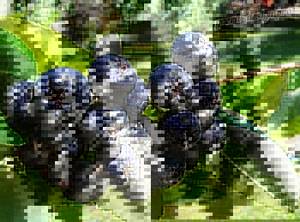
Rowan variety "black-eyed"
- "Black-eyed" . It is considered an unpretentious, disease-resistant plant. In addition, it is an excellent honey plant. The berries reach up to 1 centimeter in diameter. The difference from other varieties is the astringency of the fruit.
- "Nero" . Shade-tolerant variety. Leaves are dark green. The fruits contain many vitamins and antioxidants.
- "Viking" . Gives high yields. The fruits are shiny and quite large.
Chokeberry or chokeberry is a useful and beautiful shrub that will bring many health benefits and will organically complement the site.
Aronia varieties and seedling selection
There are quite a lot of chokeberry varieties. The most popular of them are:
- Hakkiya;
- ruby;
- Viking;
- black-eyed
Varieties differ in taste and when fruit appears. Therefore, it is recommended to choose a seedling in special nurseries or take a shrub from a nearby area as a basis.
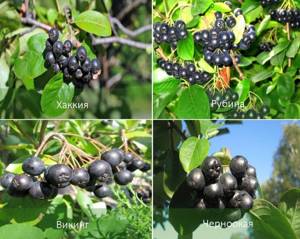
You need to choose an annual or biennial plant. The height of the seedling is up to 1.3 meters, the bark is without damage, and the roots are at least 25 cm in length. Chokeberries can bear fruit for 30 years.
How to plant: stages of work
The planting hole and substrate for the seedling are prepared in advance
, preferably 1-2 months in advance. During this time, the soil mixture is structured, and the nutrients will take on forms that are easily absorbed by the plant’s roots. The optimal pit size is 60x60x50 (cm), planting pattern is 2.5x4 (m).
To prepare the substrate, you will need the top layer of soil removed while digging the hole. It is supplemented with components:
- humus or compost 2 buckets;
- superphosphate 120 g;
- potassium sulfate 60 g.
A drainage layer of broken brick or crushed stone is laid at the bottom of the pit, no more than 15-20% of the total volume.
Before planting, the seedling needs to be inspected again
. If damaged roots are found, the problem areas are cut off to healthy skin, and the dried ones are placed in water for 10 hours.
For better survival, the roots are dipped in mash made from fatty clay, mullein and water.
In order for chokeberry to take root and grow well, it needs to be planted deeper than it grew in the nursery. This is necessary to deepen the root shoots (awls) growing from the root collar.
In light soils, the seedling is buried by 6 cm, in heavy soils by 2-3 cm.
. Thus, the root collar of the bush after shrinkage of the soil should remain 1-3 cm below the ground level.
The roots are covered with soil mixture, periodically shaking the stem to avoid the formation of voids. After compacting the tree trunk circle and watering the seedling, you need to form a layer of mulch
. The following are suitable for this purpose: peat, sawdust, mown grass or wood chips.
After planting, the above-ground part of the seedling is cut off, leaving only 20 cm in length.
. When planting in autumn, the procedure is postponed until spring and carried out until the buds open.
What to look for when planting rowan in the garden
Chokeberry looks good both as a single plant and in a group. Its planting is carried out to create a hedge or in the background in composition with other plants, the cultivation of which requires light shading.
In order for chokeberry to bear fruit abundantly and for the berries to ripen evenly, you need to choose the sunniest place in the garden for it. It tolerates partial shade, but with a lack of sunlight, the yield is noticeably reduced.
Planting is carried out at some distance from other plants. If the plants do not exceed it in height, then it is advisable to maintain a distance of two meters. When planting next to tall trees, leave at least three meters between them.
Chokeberry, growing singly, does not require formative pruning; the shoots themselves form a beautiful spreading crown. In order for the yield to be consistently high, only sanitary pruning of old, weak and damaged branches is carried out annually.
If the purpose of the rowan is to decorate the garden, then you can form a spherical crown, which must be maintained by periodically removing unnecessary branches. Berries will form on the bush, but in smaller quantities.
If rowan berries are grown to create a hedge, then the bushes are planted closer to each other. A distance of 1.5 meters between plants is allowed. Maintenance will include constant formative pruning. Without it, the shoots will rush upward, and the lower parts of the trunks will be exposed, which will make the fence unattractive.
Conclusion
Chokeberry bushes require careful care in the first year after transplantation, when regular watering is necessary for better rooting. In the future, it is enough to prune and fertilize in the spring, and during the summer it is advisable to mow the grass near the trunk and water during drought.
Chokeberry in Russia is often called chokeberry, but these crops are not close relatives; they are united only by belonging to the same family - Rosaceae. It is grown everywhere as an ornamental, fruit and medicinal plant. It’s not for nothing that the name of the bush is translated from Greek as “help”, “benefit”.
Care after landing
The shrub's maintenance requirements are minimal. In addition, it is rarely affected by pests and diseases.
. This makes it especially attractive for growing in the country, where the presence of a gardener is not constant.
Shelter for the winter
A seedling planted in the fall needs to be prepared for the first winter season. To do this, bend it to the ground and press it with boards.
. It is important to do this until the air temperature drops to -1°C—2°C.
Otherwise, the stem of the bush will lose elasticity and may break. When bending the bush, it is important to ensure that the height of the arc does not exceed 20 -30 cm
.
Additionally, the seedling is covered with spruce branches
, and the mulch layer is made higher. In winters with little snow, the bush is covered with snow.
In the spring, when a stable temperature has established, the plant needs to be straightened. If you keep it bent down for a long time, the apical shoots can prop up.
Do shoots need to be trimmed?
A feature of chokeberry is the rapid formation of shoots, which leads to a strong thickening of the crown. Therefore, the root shoots of young bushes are removed annually, leaving only 5-6 that are stronger and growing in the right direction.
For the correct balance of stability and yield, an adult shrub should have 30-50 strong trunks
.
Sanitary pruning consists
in removing old, rotten and bare branches. The shrub lays fruit buds on annual shoots, so they should not be shortened.
To increase the productivity and life expectancy of the shrub, rejuvenating pruning should be carried out every 3-4 years.
. During the procedure, chokeberry shoots are shortened by half their height.
Top dressing
Chokeberry responds well to fertilizing, which should be done twice a year.
. To do this, the following must be embedded into the tree trunk circle per 1 m2:
- ammonium nitrate 20 g (in spring);
- potassium salt 20 g, superphosphate 30 g (autumn).
Good results are obtained by foliar feeding of shrubs after flowering.
when fruits begin to set. To do this, it is sprayed with an aqueous solution of urea (20g/10l).
With the accumulation of excessive amounts of nitrogen, the growth and duration of formation of root shoots increases. In young shoots, the bark does not have time to become lignified and the apical bud does not form.
This leads to severe freezing even in the most favorable winter. Therefore, nitrogen fertilizing should not be done in the second half of the growing season.
.
Watering and loosening the soil
Chokeberry is a moisture-loving crop
. Watering is especially important for it at the beginning of the growing season and during fruit formation.
In persistent hot weather, the bush is watered every week. The water requirement for an adult shrub is 30 liters
.
To do this, you can make watering furrows at a distance of 30-40 cm from the trunks of the bush. With this method, water will penetrate to all the roots of the plant.
Twice a season it is necessary to loosen the soil in the tree trunk circle, while removing weeds. The autumn procedure is especially important.
Excessive soil compaction contributes to severe soil freezing
in the root layers, which significantly reduces the winter hardiness of the shrub.
